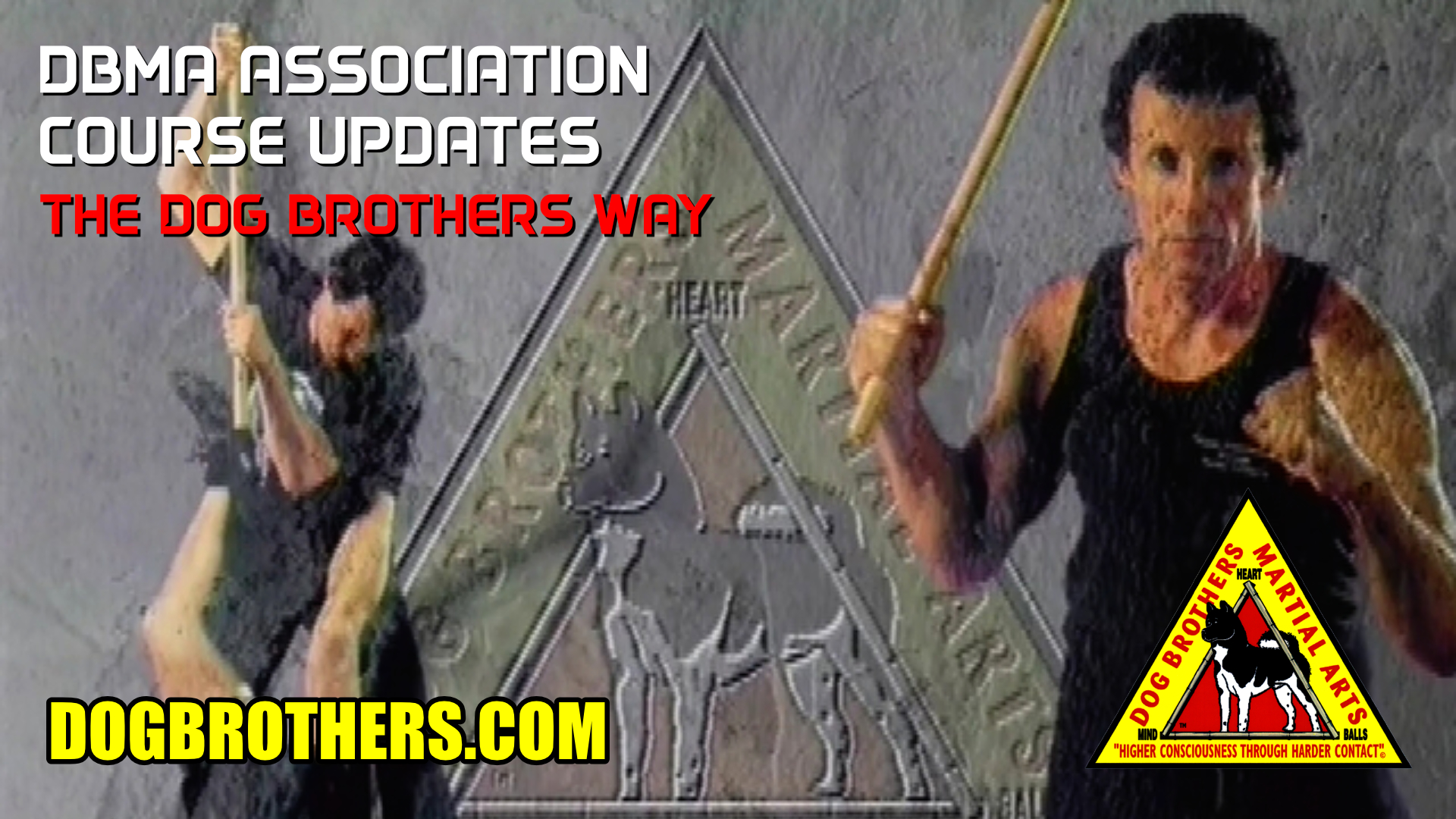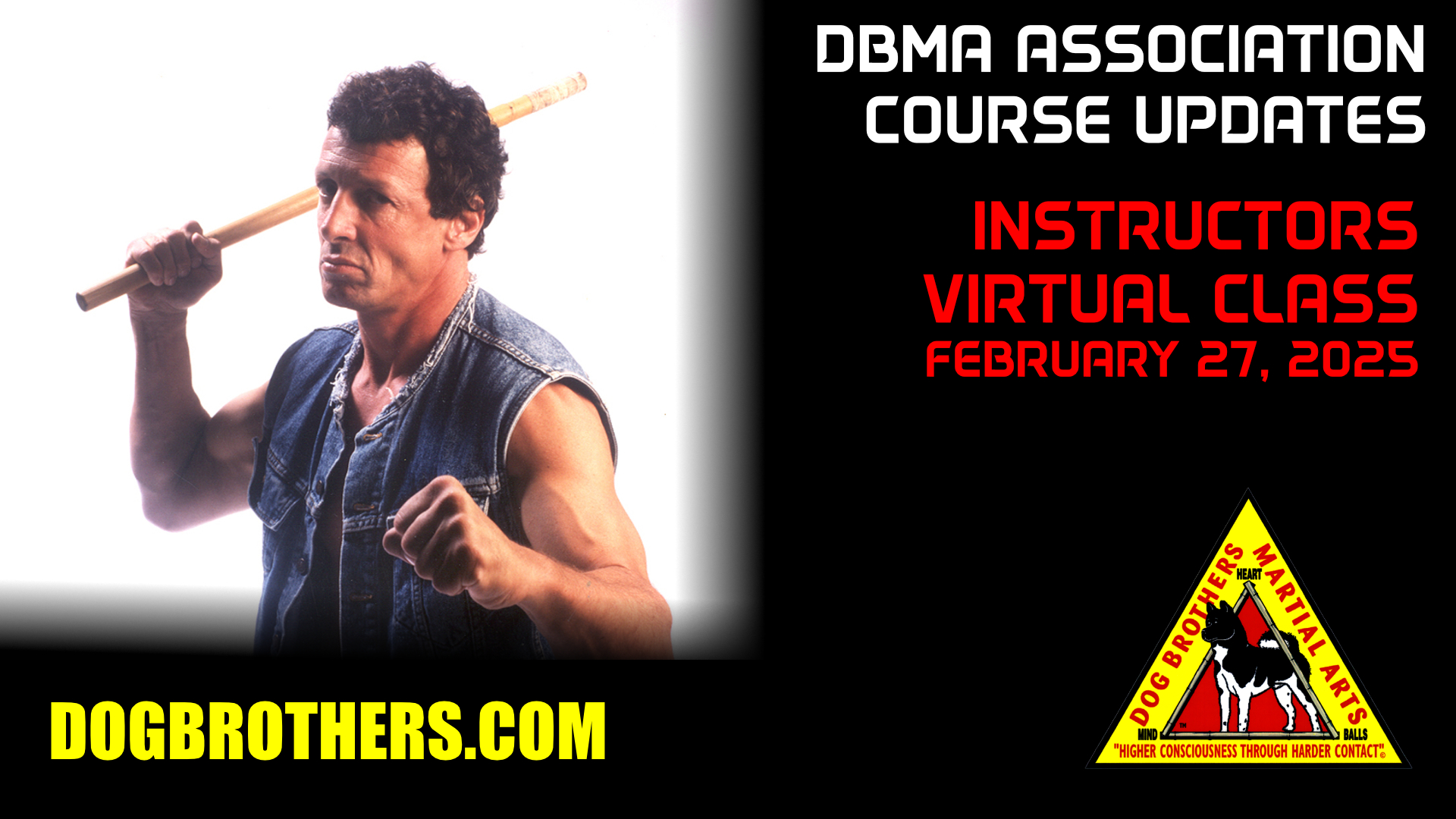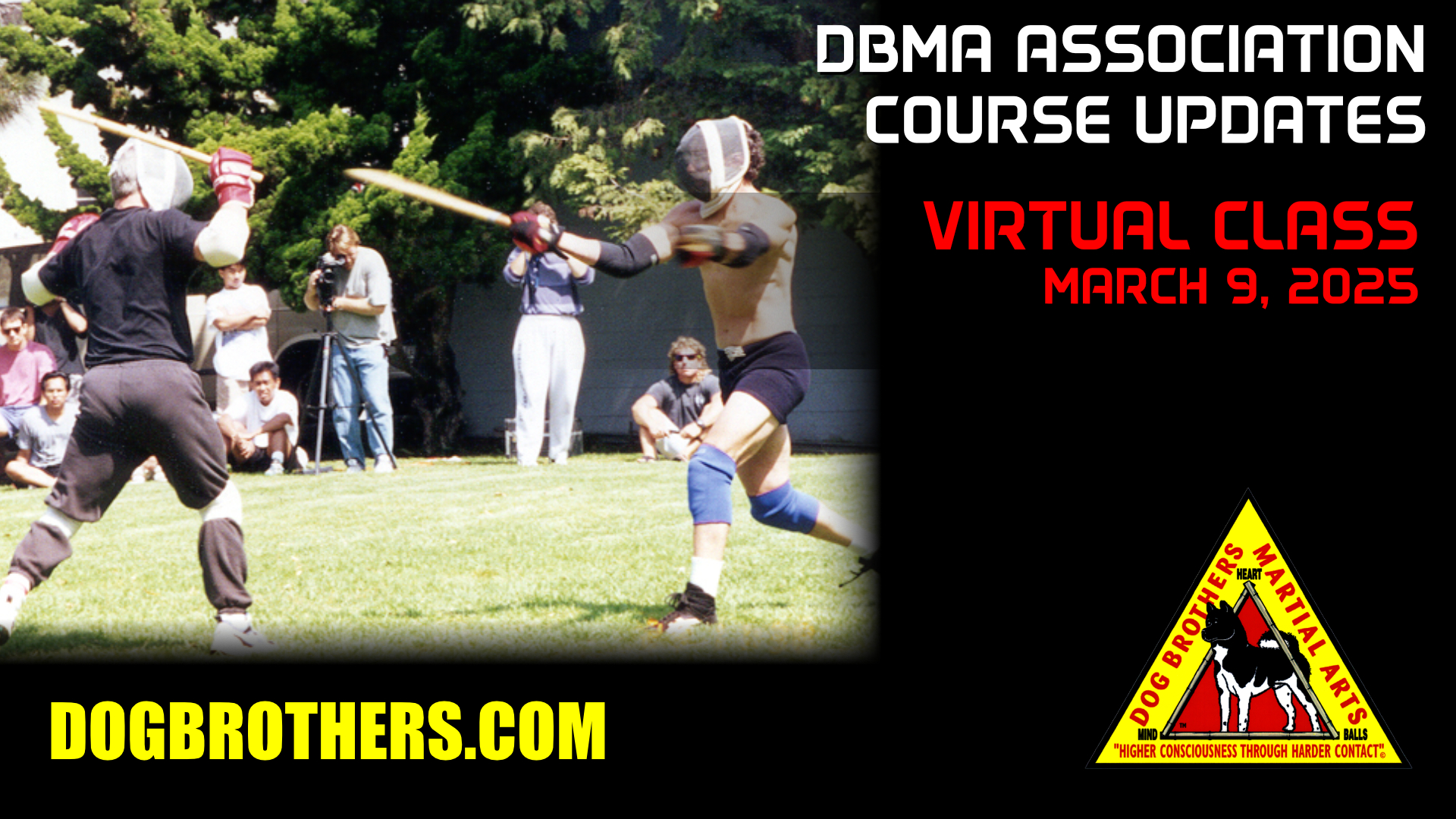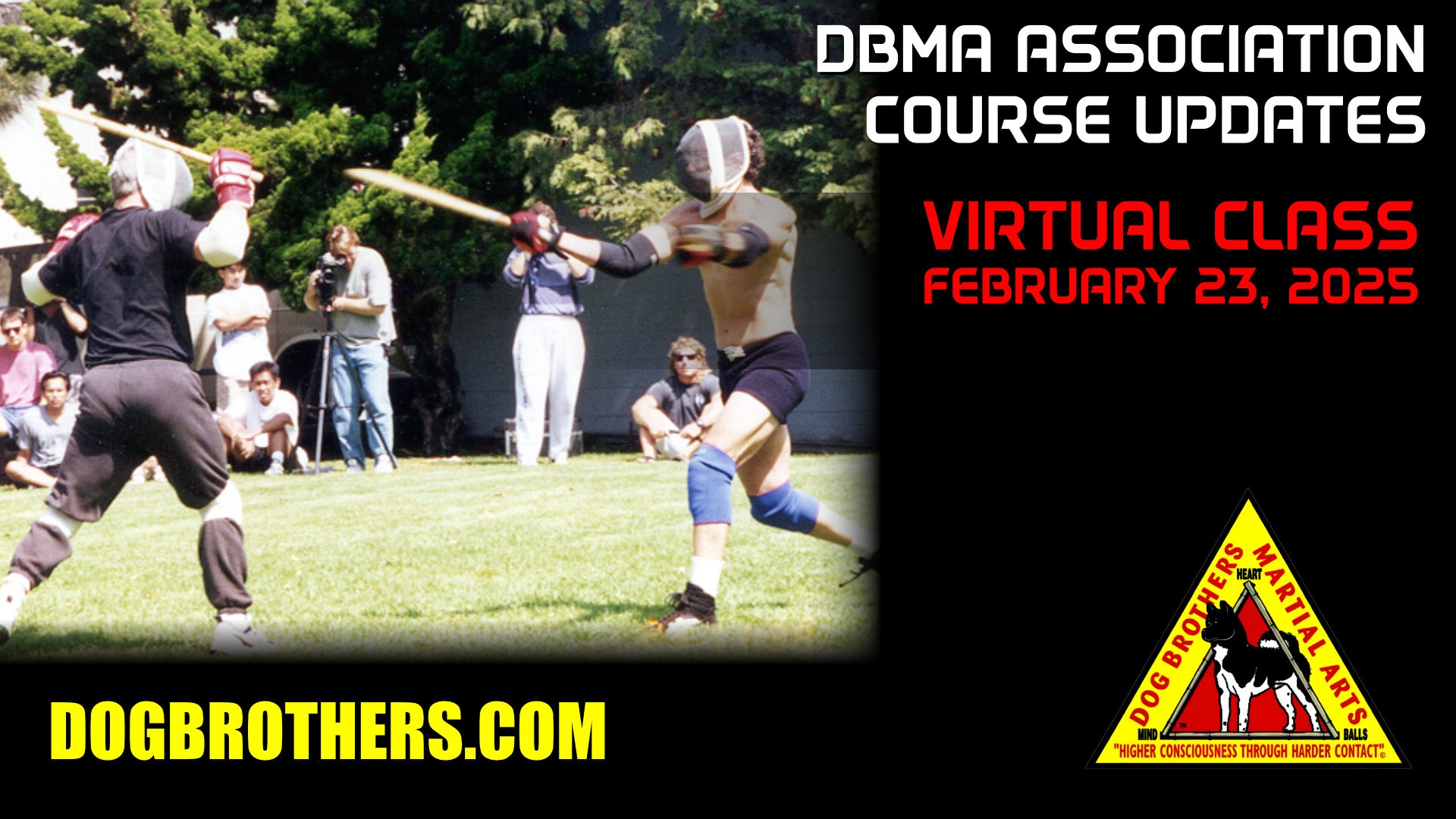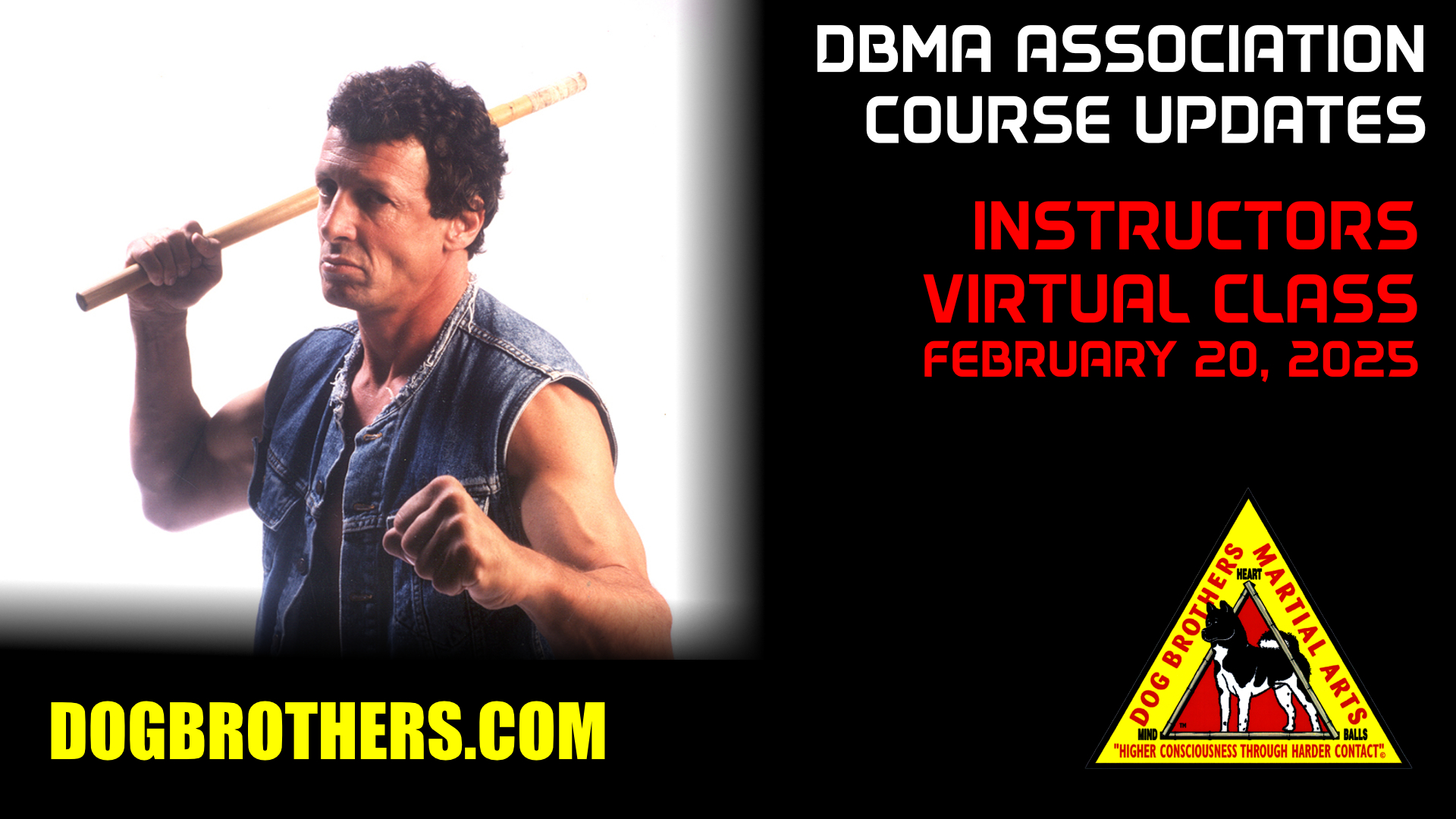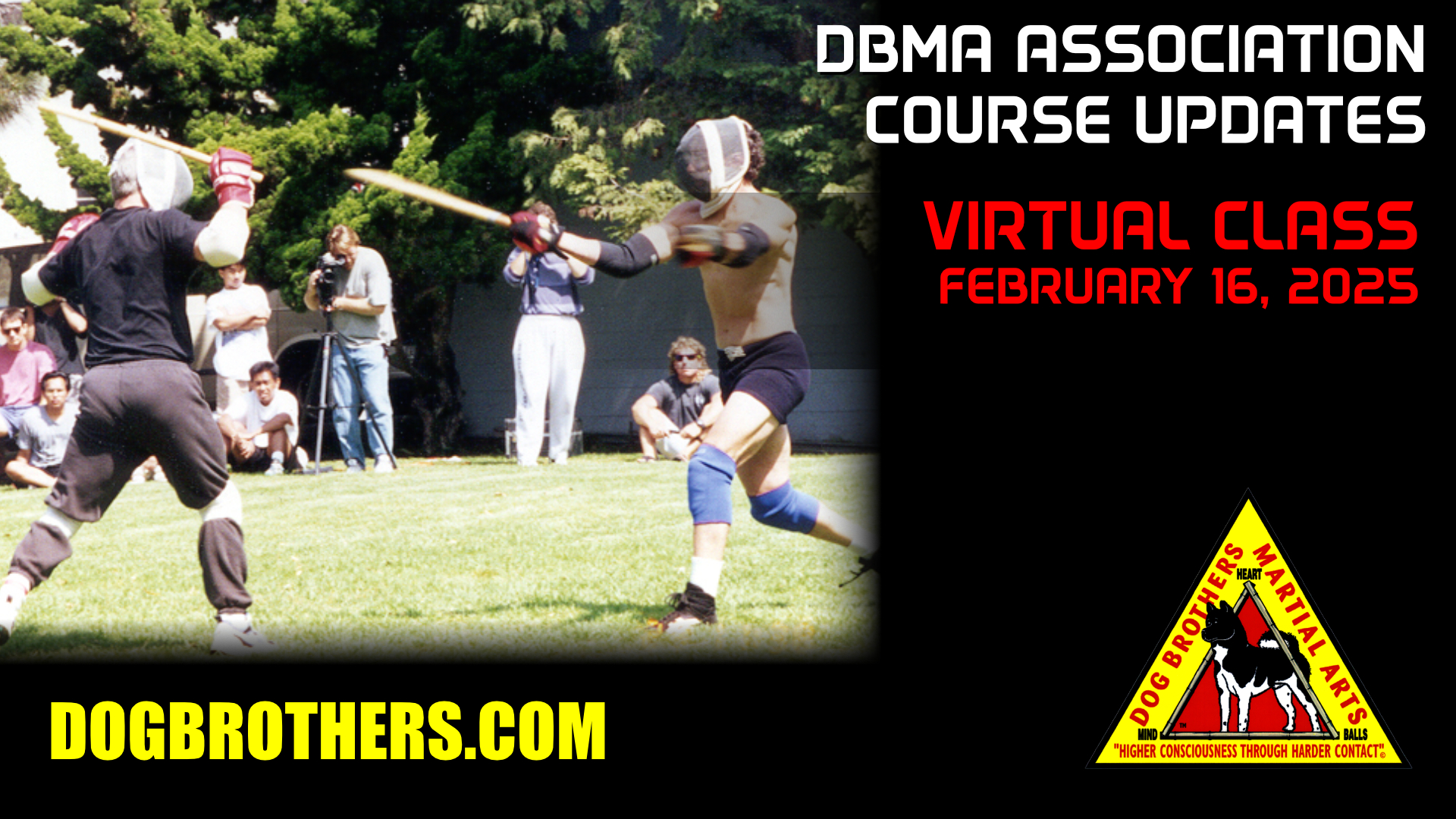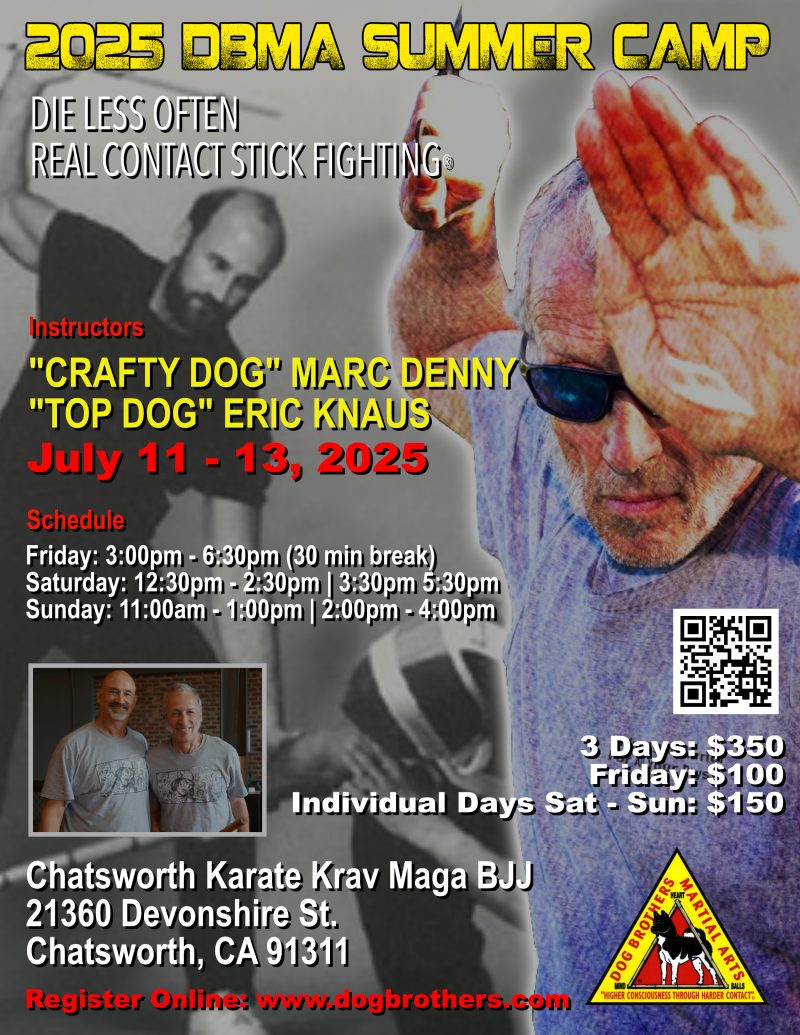
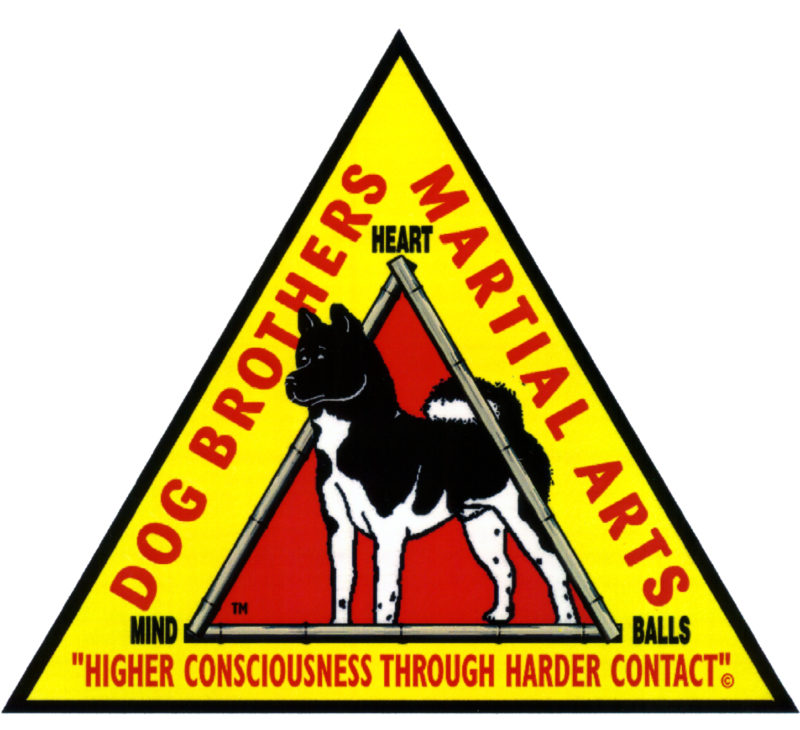
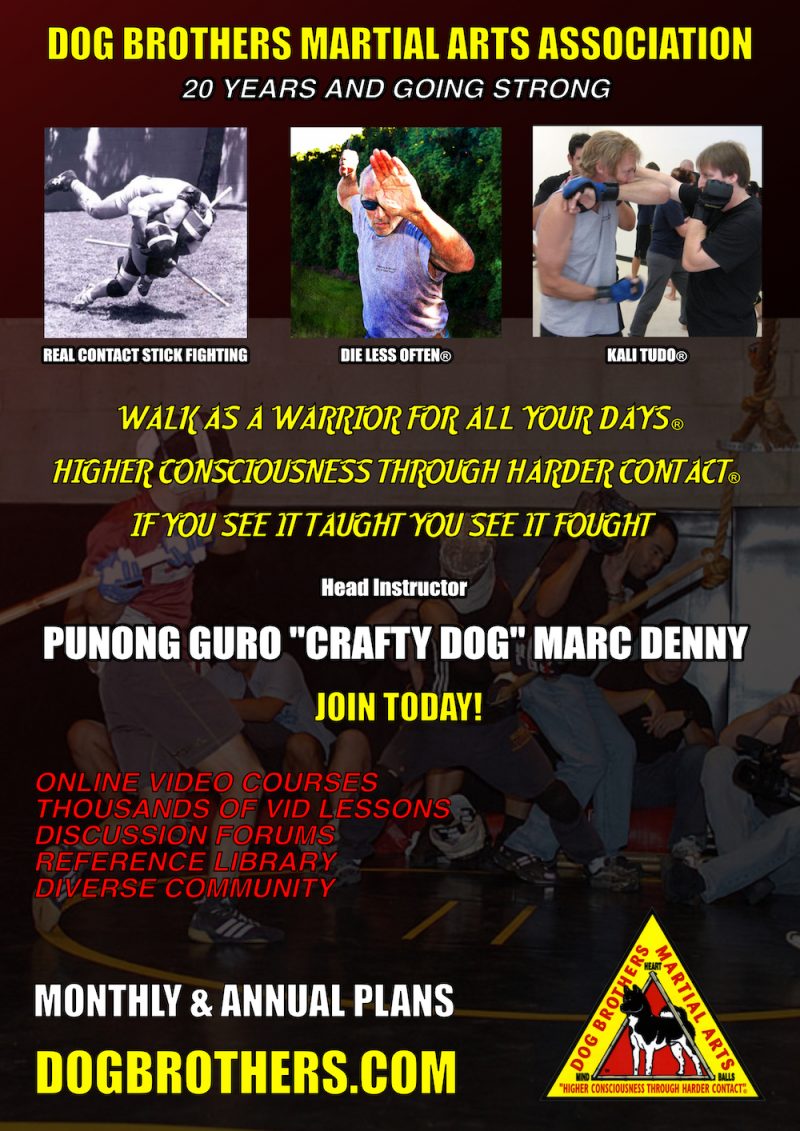
Latest Updates
New Course: The Dog Brothers Way
View Course Greetings DBMA Association Members! New Course: The Dog Brothers Way A great piece…
Course Update: DBMA Instructor Class – February 27, 2025
View Lesson
Course Update: Crafty’s Class – March 9, 2025
View Lesson
Course Update: Crafty’s Class – February 23, 2025
View Lesson
Course Update: DBMA Instructor Class – February 20, 2025
View Lesson
Course Update: Crafty’s Class – February 16, 2025
View Lesson
Where Do I Begin?
Greetings — or as we often say around here — Woof!
A question we often get is the simple yet profound “I like what I see and want to get involved. Where do I begin?” This question is asked by beginners, and by those with experience in other systems.
Step 1: Join The Association!

Join the DBMA Association. Our online training library is an immense resource that you will use frequently. Everything is organized for you in one place and very easy to locate.
Certainly you may decide to pick and choose lessons according to your interests. We have put considerable effort into our videos both being accessible to the less experienced and having substance for the more experienced. Although we also have also designed most of our courses to be able to “stand alone” so that the experienced can pick and choose those courses which address subjects of particular interest to them, our intention is that there be a cumulative “the sum is greater than the parts” quality when all the lessons are studied and trained.
Our website has a considerable amount of information as does our Martial Arts forum.
Step 2: Study Your Courses!

If you wish to “begin at the beginning”, the questions remains as to exactly “Where to begin?” Avoiding fortune cookie witticisms such as “At the beginning, Grasshopper” or “The longest journey begins with the first step”, for most people we suggest the following progression to establish a good foundation upon which to base one’s subsequent development:
- The six volume series “Real Contact Stickfighting” featuring Eric “Top Dog” Knaus and the Dog Brothers. Although we released this series in the fall of 1993, that it continues to be a solid seller 15 years later is a remarkable thing and is a great testament to the extraordinary performance of Top Dog.Extraordinarily graceful for a true heavyweight (6’4″ and 220 pounds) and the “Fighting Force” around whom the Dog Brothers first coalesced, this series is focused on solo training. TD shows a movement, the viewer trains a round with him, then there is a fight– as we saw in Dog Brothers Martial Arts “If you see it taught, you see it fought”. To be able to install stick skills modeled on the dominant fighter of his time is a great way to begin.
- “Krabi Krabong” by Ajarn Arlan “Salty Dog” Sanford” : Krabi Krabong is the Thai military weaponry system from which the ring sport of Muay Thai descends. Dog Brothers co-founder Salty Dog traveled to Thailand many times to train and become certified by the legendary Buddaiswan Institute as an “ajarn” (teacher/guro) in KK and used it to change the face of Dog Brothers fighting.This is where your two man training begins. Although anyone with a background in Muay Thai will find this material particularly accessible, the material is primal and power crazed– always a good thing to have for true fighting skills!– and readily learned by all. This is where you learn to step through with power and establish the foundations of what we call “bilateralism”– the ability to fight with either side forward, which will be very important down the road as you develop your skills for operating in “360 degree” situations that might arise in the real world. The drills are actually rather simple, which means that in short order can be trained with power, speed and aerobic intensity. As always– “If you see it taught, you see it fought”– plenty of good fights showing what you are learning in action.
- “Combining Stick & Footwork” by Guro Marc “Crafty Dog” Denny. Real fights move! One of the most important fighting attributes in real fighting is to be able to hit and block while moving. Building on the what you trained with Ajarn Salty in the KK DVD, Guro Crafty introduces the triangular footwork of Kali and the basic stick combinations from the Lameco system integrated with footwork and shows how to attack and defend knee attacks. Two man drills done in rhythm allow you to develop your coordination and honestly assess the efficiency of what you are learning.
With these in place, you will be ready to begin exploring the other courses.
Step 3: Find a qualified instructor!

Check our Instructor Page to find a qualified Dog Brothers Martial Arts Instructor and Training Group near you! Find A Qualified Instructor!
Step 4: A Personal Training Program!

If you want to really deepen and accelerate your growth, a Personal Training Program is the way to go. A PTP allows me to really focus on the particular individual(s) in front of me, whether beginner or advanced.
I enjoy what I do and with someone earlier in his/her path, my goal is to unlock his particular combination of learning modalities (visual, verbal, kinetic, etc) and install the building blocks that will best serve him to not only become someone to be reckoned with in short order but also serve as a sound foundation for growth over time. After all, the mission is to walk as a warrior for all our days! Learn More!
Step 5: Host A Seminar!

Learn more about our seminar program! Have Punong Guro Crafty visit your school and receive personal instruction and supervision to accelerate the learning process! Learn More About Our Seminar Program!
The Adventure continues,
Punong Guro Marc “Crafty Dog” Denny
FAQ
QUESTION: What is the difference between “the Dog Brothers”, “Dog Brothers Inc. Martial Arts” (DBIMA) and “Dog Brothers Martial Arts”?
The Dog Brothers are a band of sweaty, smelly, psychopaths with sticks. DBIMA is the corporation founded by Marc “Crafty Dog” Denny. It is the vehicle through which the “Gatherings of the Pack” are hosted and through which Guro Crafty teaches. In addition to its business purposes, (e.g. video production) it serves to protect Marc from personal liability. DBMA is “the system of many styles” which has evolved out of the interplay of what we have been taught and our experience. Except for Guro Crafty, all DBMA instructors are NOT employees, agents, etc. of DBIMA.
QUESTION: Where does the name come from?
It comes from the interplay of a couple of serendipitous events. At “the Rumble at Ramblas” (5/88) we had three fighters named Marc/Mark, (Denny, Balluff, and Sanden) and there was also Mark Lawson, who was part of things, but wasn’t at the RAR. Naturally, to minimize confusion the search for nicknames was on. Something happened that led to someone calling me a “crafty dog”, and Mark Balluff spoke very well in his interview about how the experience led to a feeling of brotherhood (see the end of DB #1). That week I was reading a Conan the Barbarian comic book wherein Conan is leading a band of warriors into battle saying, “Come on you dog-brothers!!!” and it hit me. Since then the name has revealed itself to be a more fortuitous metaphor than we knew at the time.
QUESTION: What does it take to become a Dog Brother?
Although many of the Dog Brothers have come out of DBIMA or DBMA instructors, this is NOT necessary in order to become a Dog Brother. If you wish to become a Dog Brother, fight at some of the Gatherings, let the Brothers get to know you, and find someone in the group to present your name to one of the Marc “Crafty Dog“ Denny or Benjamin “Lonely Dog” Rittiner” – and he will take it from there.
The first level is “Dog” one is accepted into the tribe. The next level is “Candidate Dog Brother”. At this point, one is showing the level of realization in fighting that we expect of a “Dog Brother”. A name is tentatively given. Typically, we look for this level to be maintained for at least three Gatherings. Then one reaches the grand exalted status of “Dog Brother”.
QUESTION: What can you tell us about your credo, “Higher Consciousness through Harder Contact ©”?
At the beginning of a “Gathering of the Pack”, a passage in the magic words that begin the day goes, “No judges, no referees, no trophies. One rule only Be friends at the end of the day. This means no one should spend the night in the hospital, and everyone should leave with the IQ that they came with.”
There are too many ways that human ingenuity can come up with to damage someone else irreparably, especially with a stick, for us to think up and be able to enforce rules against all of them. The spirit of the fights is that of members of the same tribe helping each other to prepare to defend the land, women, and children of the tribe. Both going too hard and going too soft are counterproductive. In this spirit, what might be too much for one man to handle, could be too little for another. It is a sign of respect for your “opponent” to really go after him-you are saying you respect and believe in his skill and spirit to deal with it, yet at the same time even in the adrenaline of the moment you are looking out for his welfare so as to not damage him and thus weaken the tribe. It is in your best interest that he be as good a warrior as possible when you stand together in battle.
A stickfight is an intense adrenal experience. The Learning that takes place in this altered state is of an entirely different order from ordinary learning. The greater the intensity of the fight, the greater the need to simultaneously tap into a centered awareness that keeps you from taking the shot that would be too much. The cultivation of this duality, i.e. greater adrenaline & greater centering, is what we mean by the full credo: “The greater the dichotomy, the profounder the transformation. Higher Consciousness through Harder Contact.” It is our hope and belief that this deeper learning carries over to the rest of one’s life; and should one ever need to use one’s skills that it will be done with a calmness that allows for good judgement as well as good skill.
QUESTION: Do you guys do this all the time?
To do this all the time is something we haven’t done since we were much younger. Ajarn Salty Dog makes a good point when he says that it is probably a good thing to have a phase in one’s evolution where one does do this a lot so as to step through a certain door. For many of us, this was the significance of the “Rumble at Ramblas”- we averaged 20 fights each over the course of three days. To go out on the field again and again is a transformational experience. We come to see our fears as no different that a dog’s fear of a vacuum cleaner.
What we do now is have two “Gatherings of the Pack” a year. One is the first Saturday of May, and the other is the Saturday of September closest to the autumnal equinox. For the seasons here in southern California these dates seem to work well. We also usually hold one or two “Closed Door Gatherings” between Gatherings. These are only open to members of the tribe. They are a chance to stay sharp and to experiment without the public watching.
QUESTION: How does someone prepare to do this for the first time?
This can vary wildly. We have had someone go out and fight after only 9 lessons with the stick. However, he had been a nationally ranked collegiate wrestler and then a bounty hunter, was a purple belt in Machado Brazilian Jiu Jitsu, and has the tendon strength of an orangutan, (he once opened a fighting pit bull’s jaws!) the neck of a bear, and the skull of a bowling ball. However, most people require a couple to several years of training to prepare to fight at a “Gathering of the Pack”. The panoply of skills called for is quite broad. Some people prefer to specialize in their natural strengths, others to develop as broad a range of skills as possible. We believe our curriculum offers a sound basis for DBMA’s mission of “helping good people learn to fight well for real.”
We believe the ultimate goal is to have real skills throughout the entirety of one’s life, not just when one is young and competitive. This calls for an open mind. “A conclusion is but a place where one stops thinking.” (unknown) The core training philosophy of DBMA is that of JKDC-Jeet Kune Do Concepts. Bruce Lee said, “Research your own experience. Absorb what is useful. Reject what is useless. Add what is specifically your own.” We think this is right.
QUESTION: This stickfighting is all very nice, but what do you do when you don’t have a stick?
Well, in our opinion you always DO have a stick, actually two. They are called your forearms. We believe the claim of the FMA that empty hand strikes, parries, traps, and blocks are like the stick/blade is correct. Indeed, in our opinion, until you can really clock someone with a stick it is dubious that you can use the full empty handed array of options of the FMA.
QUESTION: So Real Contact Stickfighting is not all you do?
Exactly!!! RCSF may be what we are known for, but DBMA sees it as just a vehicle for a thorough testing and cultivation of all skills, most certainly empty hand as well, particularly in conjunction with the rest of our program.
QUESTION: So what is in your program?
We have a curriculum. The day that it ceases to evolve, it begins to die. And just as we have many fighters each with his own style, similarly our curriculum is a “system of many styles”. By this we mean that this is not a random hodge-podge of sundry techniques, but rather a SYSTEM of many styles. Considerable thought and experience has gone into the development of this curriculum.
A. The core of our curriculum is FILIPINO MARTIAL ARTS (FMA). The three principle systems upon which we draw are Inosanto Blend (Guro Dan Inosanto), Pekiti Tirsia (Grand Tuhon Leo Gaje), and Lameco (the late Punong Guro Edgar Sulite), though of course there are many others too. We consider Silat to be a part of both unarmed and weaponry FMA, and, although not Filipino, we wish to acknowledge the influence of the Indonesian system of Bukti Negara Pentjak Silat of Pendekar Paul de Thouars.
Some of the distinctive features of our system’s approach in this area are:
- There is a strong emphasis on developing the ability of what is normally the complementary hand to act as the dominant hand. This is required, in our opinion, not only to be a better stickfighter, but also to have true empty hand FMA skills. We encourage people to develop strong fighting siniwali skills as a part of using the weapon to learn to fight empty handed. In our opinion, if you cannot fight with two sticks (and fighting with siniwali is much harder than doing siniwali drills) it is dubious you can use your stick skills empty handed. Of course, ultimately it is up to the student to decide how much he wishes to cultivate ambidexterity, but usually he should first put in enough time at this to have a basis for an opinion.
- Panuntukan (FMA empty hand striking skills): In the Filipino systems that teach panuntukan, they often begin with the motions based on single knife, double knife, or espada y daga. Our progression in this area begins with siniwali motions. This aligns more readily with the Krabi Krabong part of the curriculum (see below). We do not separate the Silat material from the Panuntukan.
- Our stickfighting theory is based upon 6 ranges, not the usual three. It is our understanding that many systems in the Philippines had more than the three ranges that are typically used for teaching in the USA, and through our fighting experience, we begin to understand why.
- We believe it is important to have competent staff skills.
- We spend less time than most systems on disarms, for reasons discussed in DB tape #4. In our experience, a grasp of the general principles suffices.
- For an FMA centered system, there is a unusual amount of grappling.
B. DB GRAPPLING: Although we are but mid-level students of Brazilian Jiu Jitsu, BJJ plays an important role, both for our Vale Tudo (unarmed) system and for “Dog Brother Stickgrappling”, which will be discussed next. For those who can, we encourage them to train with our teachers and good friends, the Machado Brothers-who are right up the street from our “main den” in Hermosa Beach, CA. Although we continue to search it out, unfortunately little of the Filipino grappling has survived the trip to America.
C. “DOG BROTHER STICKGRAPPLING” is our own blend of BJJ and FMA, as well as some of stick subsystem of Bando Python , for which we are indebted to the legendary Dr. M. Gyi, Grandmaster of the Bando system.
Our feeling is that even with a stick, grappling can happen and in this range the presence of a stick changes things in important ways. A good stickgrappler has good stick skills, good grappling, and good stickgrappling and can keep track of all three simultaneously. This is a good trick and can be a quite effective.
D. KRABI KRABONG, is the weaponry and empty hand art from which Muay Thai Kickboxing descends. We are guided in this area by Ajarn Salty Dog, who is a certified instructor by the Buddaiswan Institute in Thailand.
E. “DOG BROTHER VALE TUDO” is our empty handed system: striking,(Kali-panuntukan, JFGF, KK) trapping, (Kali, JFGF) throwing (Silat and others), grappling (principally BJJ, with some other things), and striking during grappling (Kali, Silat, JFGF).
Woof,
Marc “Crafty Dog” Denny
Co-founder: The Dog Brothers
President: Dog Brothers Inc.Martial Arts
Head Instructor: Dog Brothers Martial Arts

